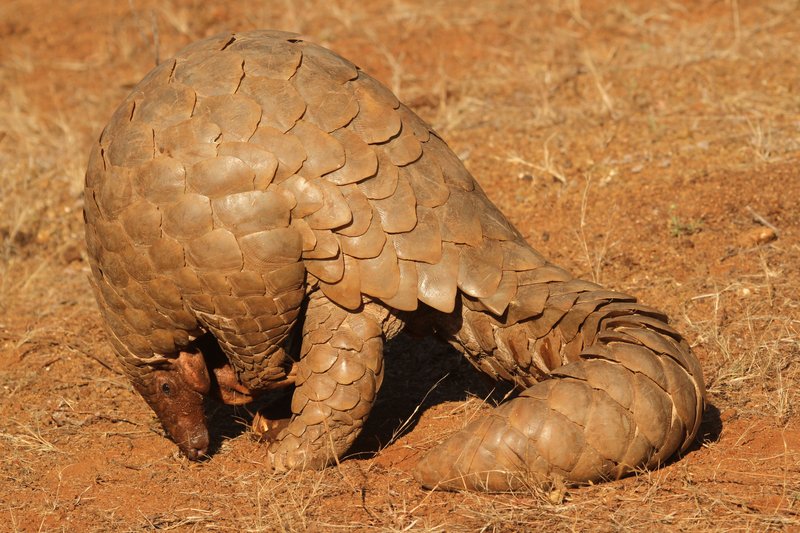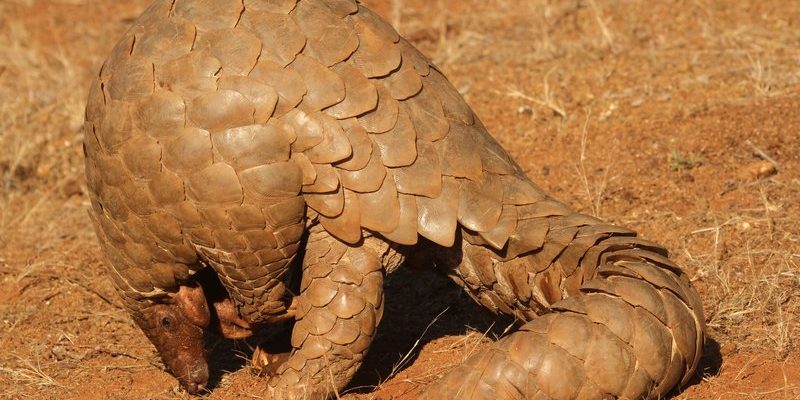
Imagine a creature that looks like a cross between a pinecone and a tiny dragon. That’s the Indian Pangolin for you! These fascinating animals are unique for their tough, scaled bodies and their knack for curling up into a ball when threatened. Often found burrowing in the earth, they play a vital role in their habitat, keeping insect populations in check. Despite their quirky appearance and significant ecological contributions, these creatures face severe threats due to habitat loss and poaching.
The Indian Pangolin is one of eight species of pangolins, and it can be found primarily in the forests and grasslands of the Indian subcontinent. With their nocturnal habits, you might not see one easily, but their presence is felt in the ecosystems they inhabit. As we delve deeper into the world of this remarkable creature, you might start to appreciate its uniqueness and the challenges it faces in today’s world.
Physical Characteristics
So, what’s the first thing you notice about the Indian Pangolin? Its scaly coat is a standout feature, made up of keratin—the same material that makes up our nails and hair. These scales offer protection against predators, while also giving the pangolin a distinctive look. When threatened, they can roll up tightly, with their scales acting as armor. It’s a clever tactic that keeps them safe in the wild.
Adult Indian Pangolins typically weigh between 10 and 16 kilograms (about 22 to 35 pounds) and reach lengths of 60 to 100 centimeters (around 2 to 3.3 feet). Their tails are long, often as long as their bodies, which aids in balance while climbing trees or navigating their burrows. With small, beady eyes and a long, sticky tongue, these animals are perfectly adapted to their insectivorous diet, allowing them to feast on ants and termites with ease.
Habitat and Distribution
The Indian Pangolin prefers a variety of habitats, including forests, grasslands, and scrublands. They are predominantly found in India, but their range extends to neighboring countries such as Nepal, Bhutan, and Bangladesh. You might think of them as the secret keepers of the ecosystem; they dig extensive burrows that create homes not just for themselves but also for other wildlife.
These pangolins thrive in warm climates and are often found in areas with ample insect populations. Their burrowing habits help aerate the soil, which can promote plant growth. Interestingly, they tend to be solitary animals, coming together only for mating. Their nocturnal nature adds an element of mystery to their lifestyle, as they are most active at night when they venture out in search of food.
| Size: | 60 to 100 cm (2 to 3.3 feet) |
| Weight: | 10 to 16 kg (22 to 35 lbs) |
| Diet: | Ants and termites |
| Habitat: | Forests, grasslands, scrublands |
| Behavior: | Nocturnal |
Diet and Feeding Habits
When you think of the Indian Pangolin, you might picture it gorging on its favorite meal: ants and termites. With a long, sticky tongue that can extend up to 16 inches, they are perfectly equipped for extracting these insects from their nests. It’s a bit like having a built-in straw for sipping on their favorite foods. They can consume tens of thousands of insects in a single night, playing a crucial role in controlling pest populations.
The pangolin’s diet isn’t just about ants and termites, though. They are known to enjoy a variety of other insects as well, which helps diversify their nutrition. Their keen sense of smell enables them to locate insect nests buried deep underground, often using their strong claws to dig them up. This behavior not only provides food for themselves but also benefits the ecosystem by aerating the soil.
Behavior and Social Structure
The Indian Pangolin is primarily solitary, with individuals only coming together during mating season. They have a pretty laid-back lifestyle, spending most of their time rummaging through the ground for food or lounging in their burrows. Interestingly, they are known to have well-defined territories, which they mark using scent. You might think of them as little introverts in the animal kingdom, preferring their own company to be in a crowd.
Despite their solitary nature, these pangolins are fascinating creatures to observe. They rely on their keen senses of smell and hearing to navigate the world around them. When faced with danger, they exhibit their signature defensive behavior by curling into a tight ball, with their scales acting as a shield against potential threats.
Reproduction and Lifespan
When it comes to reproduction, the Indian Pangolin has a relatively simple yet intriguing process. After a gestation period of about 70 to 140 days, females typically give birth to a single offspring, although twins can occur on rare occasions. The babies, called pangolins, are born with soft scales that harden over time, offering them protection as they grow. These little ones are usually weaned after about three months and stay with their mothers for up to a year, learning essential life skills along the way.
As for their lifespan, Indian Pangolins can live up to about 20 years in the wild, but many face threats that cut their lives short. These threats include habitat loss due to deforestation and illegal poaching. It’s heartbreaking to think about, as these creatures play such an important role in their environments.
Conservation Status
The Indian Pangolin is currently classified as endangered, primarily due to hunting and habitat destruction. The demand for their scales in traditional medicine and as luxury items has led to widespread poaching, making it crucial to raise awareness about their plight. Conservation efforts are underway to protect these unique creatures and their habitats.
In India, various organizations and government bodies are working together to combat illegal wildlife trade and educate the public about the importance of pangolins in the ecosystem. By protecting their natural habitats and promoting sustainable practices, we can help ensure a future for the Indian Pangolin and the diverse ecosystems they support.
Fun Facts about the Indian Pangolin
- Pangolins can consume up to 70 million insects a year!
- They have no teeth, relying on their strong stomach muscles to grind food.
- The word “pangolin” comes from the Malay word “penggulung,” meaning “one that rolls up.”
The Indian Pangolin is not only an intriguing animal with its unique appearance and behavior, but it also serves a vital role in maintaining the balance of its ecosystem. Understanding and protecting this remarkable creature is essential for preserving biodiversity. The next time you see a pangolin, whether in pictures or documentaries, remember the importance of its role in our world—and perhaps, consider how we can contribute to its conservation.
FAQ
What do Indian Pangolins eat?
Indian Pangolins primarily feast on ants and termites, using their long, sticky tongues to extract these insects from their nests. They can eat tens of thousands of ants in one night, making them essential for controlling insect populations.
Are Indian Pangolins dangerous to humans?
No, Indian Pangolins are not dangerous to humans. They are shy and solitary creatures. When threatened, they prefer to curl up into a ball rather than confront any danger. Their primary form of defense is their hard scales.
Why are Indian Pangolins endangered?
Indian Pangolins are endangered primarily due to poaching for their scales, which are used in traditional medicine and as luxury items. Habitat destruction also poses a significant threat, as forests are cleared for agriculture and urban development.
How can people help protect Indian Pangolins?
People can help protect Indian Pangolins by supporting conservation organizations, spreading awareness about their plight, and avoiding products made from pangolins. Participating in wildlife protection initiatives and advocating for strong laws against poaching are also critical.
What is the lifespan of an Indian Pangolin?
In the wild, the lifespan of an Indian Pangolin can be up to 20 years, although many do not live this long due to threats like poaching and habitat loss. Those in captivity may live longer with proper care.
Do Indian Pangolins have any natural predators?
Yes, while adult Indian Pangolins have few natural predators due to their tough scales, young pangolins can fall prey to larger carnivores, birds of prey, and even domestic dogs. However, their primary defense mechanism is curling into a ball to avoid detection.
How do Indian Pangolins find food?
Indian Pangolins rely on their excellent sense of smell to locate ant and termite mounds. Their strong claws enable them to dig into the ground and uncover these nests, where they can feast on their favorite insects.
Are Indian Pangolins social animals?
No, Indian Pangolins are typically solitary creatures. They only come together for mating purposes. Their territorial nature means they prefer to live alone, marking their territory with scent.
Can Indian Pangolins climb trees?
Yes, Indian Pangolins are capable climbers. They use their long tails for balance and can often be found climbing trees in search of food or safety from predators.
What threats do Indian Pangolins face in addition to poaching?
In addition to poaching, Indian Pangolins face significant threats from habitat loss due to deforestation, urbanization, and agricultural expansion. These activities reduce their natural habitats, making it harder for them to find food and shelter.

